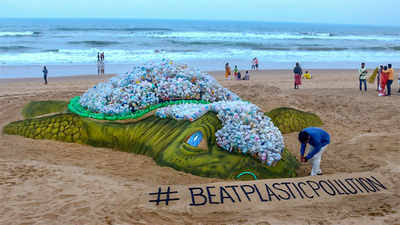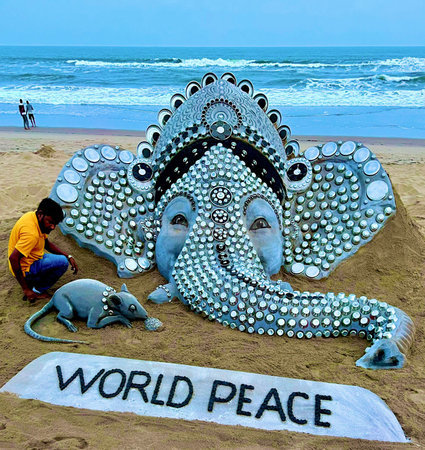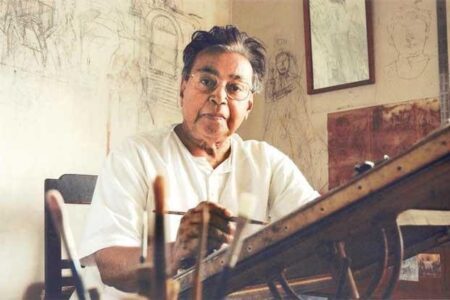A poor child sat on the beach in the predawn hush, sculpting his dreams in the golden sand. The grains whispered lullabies, soothing the gnawing hunger as the first ray of sunlight kissed the horizon. He knew this peace was fleeting—like the tides, it came and went. Still, he kept building, letting the act of creation wash his sadness away.
The child was Sudarshan Pattnaik, who would one day become a global icon of sand art and a celebrated name in India. But his journey was far from easy. In those early days, he had neither the right tools nor the support to pursue such an unconventional passion. Villagers often dismissed him, some mocking him for “playing with sand,” others simply turning away. Yet, Pattnaik’s resilience outshone the ridicule. He kept sculpting, determined to carve his path—one handful of sand at a time.
Sudarshan Pattnaik was born on April 15, 1977, in Puri, a coastal city in Odisha, India. His childhood was marked by hardship, having been born into a poor family. At the tender age of ten, he was forced to drop out of school when his family could no longer afford his education. To survive, he began doing chores at a neighbour’s house in exchange for a daily plate of food.

Yet, amid the many obstacles life threw his way, a spark of creativity began to glow within him—a quiet urge to create something beautiful out of nothing.
His family could not afford the luxury of art supplies. His mother, already burdened with caring for his grandmother and three brothers, couldn’t spare even a few rupees for a single sheet of paper. But rather than deter him, this scarcity only strengthened Sudarshan’s resolve.
Turning tides with talent
The beaches of Puri became his canvas. Every morning at 4 a.m., he would run to the shore, his heart brimming with inspiration, sculpting his imagination into the damp sand. Before anyone noticed his absence, he would quietly return home. While other children his age played together, Sudarshan spent his time shaping images of gods, goddesses, and countless other figures—giving form to dreams that the world had yet to see.

The sand was his kingdom. The tiny grains beneath his fingers became proof that even the simplest things can hold immense beauty. Sudarshan Pattnaik was a self-taught artist, drawing inspiration from everyday life—the corn vendors lining the beach, the graceful curl of a wave, and the fleeting emotions of passersby. His sculptures evolved from basic forms to intricate depictions of Lord Ganesha, Lord Shiva, Buddha, and even public figures like Prime Minister Narendra Modi.

Despite having no formal training, Sudarshan’s hands told powerful stories through sand—messages of peace, poverty, and environmental awareness. His turning point came when a local journalist noticed his work. Recognition, once unimaginable, soon followed. Invitations began arriving from around the world, and with the support of a Danish artist friend, Sudarshan was able to rent a space of his own—bringing him a step closer to the dreams he once sculpted silently on the shore.
Art that leaves a mark
In 1994, he founded the Sudarshan Sand Art Institute in Puri, with the hope of nurturing this unique art form and passing it on. The dream that began in solitude now became a collective vision. Sand art—often dismissed as child’s play—began receiving the attention and respect it truly deserved.
With nothing but raw talent and unwavering determination, Sudarshan stepped onto the global stage. He participated in numerous international sand art festivals, proudly representing India. Recognition followed like a guardian spirit. Over the years, he has won more than 27 international awards, including a Guinness World Record in 2017 for the world’s tallest sandcastle. In 2014, he was honoured with the Padma Shri, one of India’s highest civilian awards, for his contribution to the art form.

But Sudarshan’s creations are more than artistic expressions—they are reflections of pressing global concerns. On World Environment Day, he sculpted a turtle ensnared in plastic waste to highlight pollution. In another work, he recreated the Jagannath Temple in sand, honouring the heritage and spiritual essence of his homeland. And when the sea eventually reclaims his work, he doesn’t mourn. For him, the ocean is part of the process—its erasure a metaphor for life’s fragile, fleeting beauty.
Most recently, Sudarshan Pattnaik became the first Indian to win the Fred Darrington Sand Art Award in 2025, adding yet another feather to his cap. The honour was conferred at the prestigious Sandworld 2025 International Sand Art Festival in Dorset, England. To commemorate Fred Darrington’s birth centenary, Sudarshan sculpted a magnificent 10-foot figure of Lord Ganesha, etched with a message of World Peace. Crafted solely from sand and water, the sculpture stood as a testament to his belief: that greatness lies not in lavish materials, but in the depth of one’s vision.




